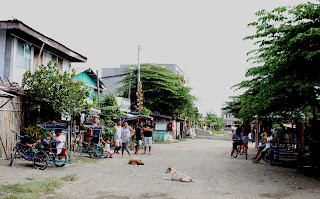Written by Traceline Choo
Photographs by Melissa Chia
Jaro is one of the areas where relocation sites in Iloilo city are located. Relocation sites are places where citizens are placed when their houses are demolished for urban development purposes by the government. But, as organizations like Kadamay would agree, these citizens are not given attention by the government and most of them are facing financial problems and lack access to clean water.
An old couple staying at the San Isidro Jaro relocation site explains that miscellaneous chores such as laundry, gardening and collecting rubbish are their sources of income. Even then, they are unable to make ends meet. “I do not have money to pay for my wife’s medication, and I depend on help from the neighbors,” the elderly man said. There was a time when he literally had to sneak his wife out of the hospital as they were unable to afford her hospital bill. These days, Tita uses salt and gasoline as medication to relieve her pain. The government of the Philippines does not offer any form of support to the old couple or most of the other families in this Jaro relocation site. In fact, it seems that one woman living there with her family reports that she is obliged to vote for the current mayor in this upcoming election as she owes her land to him.
The couple's single room shack
The land in this relocation site is distributed based on whether or not the families have any forms of leverage with the government or city councils. In other words, a family who has relatives within the government may be privileged when it comes to choosing preferred land in the relocation area. Hence, it is not rare to see a family as large as 13 people allocated to a small hectare of land area, as explained by the chairperson of San Isidro Jaro. Most household incomes range from PHP 100 to 200 a day. “We budget and limit our expenditure. If we earn more, we spend more; if we earn less, we spend less”, said a mother of three young children.
The days between June and November are described as the worst days of the year, as that is the rainy season. Floods are a common natural disaster in the area and in some parts the water level can go up to an average adult’s waist level. The walkways of the area become extremely muddy, and it is hard for the citizens to continue with their daily routines.
The residents access water by pumping underground water with a manual water pump located at several places in the community. The water is then used directly by the households without any filtration. Water issues and an unbearable living environment are shared problems that the families that were being interviewed for this article reflected on. Nonetheless, as mentioned by a lola (grandmother) living with her son and grandchildren, no matter which mayor or party wins this upcoming election, she does not believe that changes will be made.
When compared to the living condition of San Isidro Jaro, Barangay Kagawads Jaro district seems to be in a more fortunate situation. A public school is situated within walking distance of the Barangay relocation site. Houses are parted with bamboo fences; however, as stated by a resident, they do not normally have cement floors. Families that are able to have three meals a day consider themselves more fortunate than those who are only able to have one meal a day.
A new current residential project for 4000 households is currently under construction by the Iloilo City mayor. However, some have suggested that this project is to enhance the current mayor’s portfolio, and is being carried out in conjunction with the upcoming election.
When we met up at the end of the day, a talk given by the Kadamay organization stated that the serious issues surrounding the urban poor are symptomatic of wider problems in the Filipino governing systems.
Blogger Profile
Tracy is a 2nd year Communication student who will be on study exchange to Australia and Europe in 2013. She has been an advertising intern in Malaysia and Singapore, as well as contributor to the cover page of the Monash International Magazine (MIMA) 2012 issue. Upon graduation, she is determined to pursue a career in the field of mainstream media.




No comments:
Post a Comment